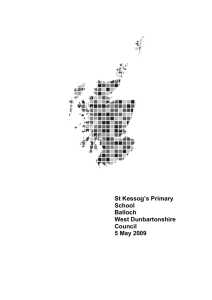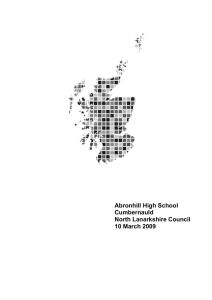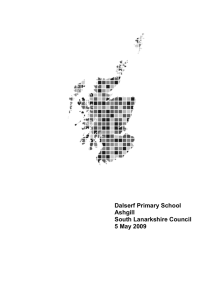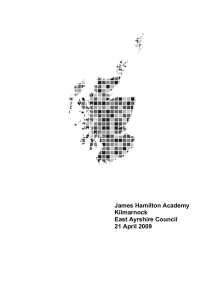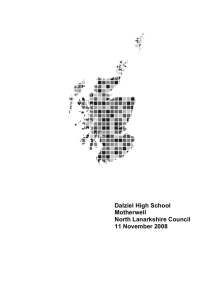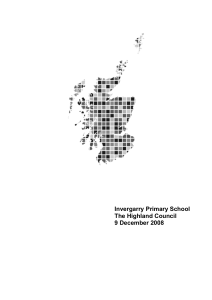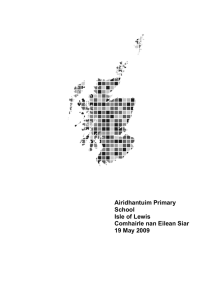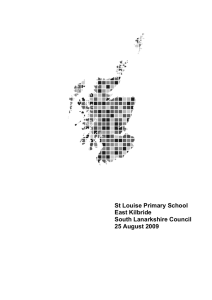Buckie High School The Moray Council 13 January 2009
advertisement
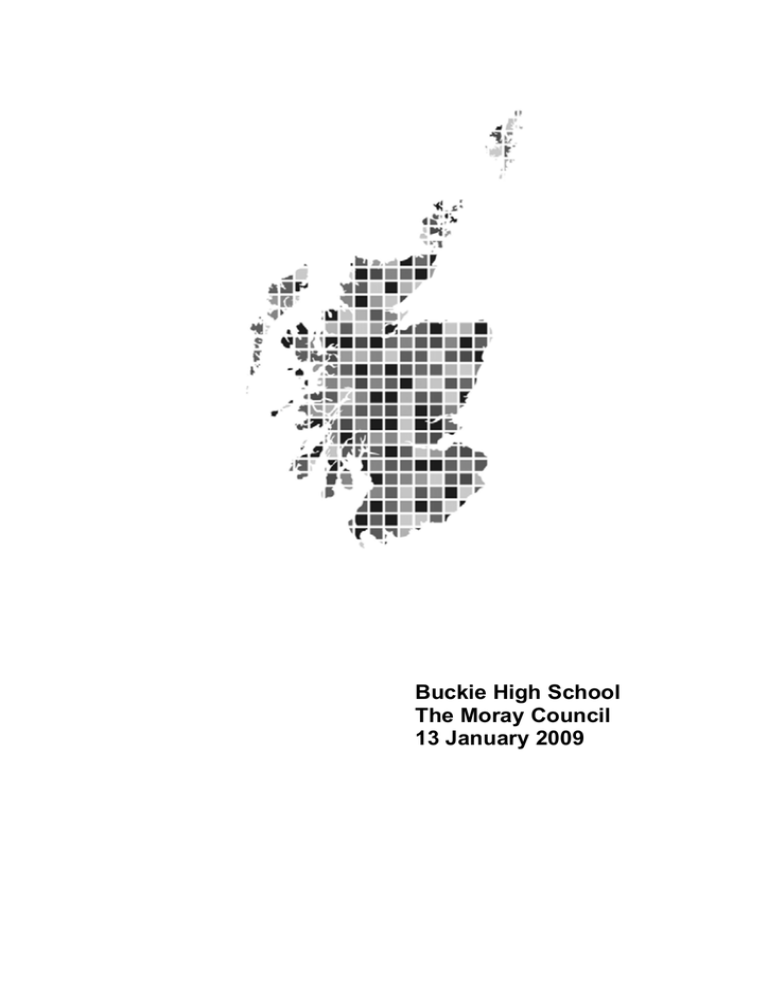
Buckie High School The Moray Council 13 January 2009 This report tells you about the quality of education at the school. We describe how young people benefit from learning there. We explain how well they are doing and how good the school is at helping them to learn. Then we look at the ways in which the school does this. We describe how well the school works with other groups in the community, including parents1 and services which support young people. We also comment on how well staff and young people work together and how they go about improving the school. Our report describes the ‘ethos’ of the school. By ‘ethos’ we mean the relationships in the school, how well young people are cared for and treated and how much is expected of them in all aspects of school life. Finally, we comment on the school’s aims. In particular, we focus on how well the aims help staff to deliver high quality learning, and the impact of leadership on the school’s success in achieving these aims. If you would like to learn more about our inspection of the school, please visit www.hmie.gov.uk. Here you can find analyses of questionnaire returns and details about young people’s examination performance. Where applicable, you will also be able to find descriptions of good practice in the school and a report on the learning community surrounding the school. 1 Throughout this report, the term ‘parents’ should be taken to include foster carers, residential care staff and carers who are relatives or friends. Contents 1. The school 2. Particular strengths of the school 3. Examples of good practice 4. How well do young people learn and achieve? 5. How well do staff work with others to support young people’s learning? 6. Are staff and young people actively involved in improving their school community? 7. Does the school have high expectations of all young people? 8. Does the school have a clear sense of direction? 9. What happens next? 1. The school Buckie High School is a non-denominational school which serves the town of Buckie and surrounding areas. The roll was 903 when the inspection was carried out in October 2008. Young people’s attendance was in line with the national average in 2006/2007. 1 2. Particular strengths of the school • The strong lead given by the headteacher and the senior leadership team to improving the school. • Staff teamwork and commitment to improving the quality of education. • The broad curriculum which provides many opportunities for young people to achieve. • Strength of partnership working with external agencies to support and enhance learning. • The support provided by staff for young people with additional support needs. 3. Examples of good practice • Approaches to developing citizenship skills through partnership working with a school in Tanzania. • Using digital examination papers to help young people with additional support needs including those with dyslexia. 4. How well do young people learn and achieve? Learning and achievement Young people in most classes are well motivated and on task with their learning. They are actively involved in their learning and work well together so that they learn from each other. They enjoy lessons and are increasingly involved in reflecting on their progress but most are not yet fully aware of how to improve. Young people participate in a wide range of activities out of the classroom. Through these, they are developing responsible attitudes and 2 improving their health and wellbeing. Young people are happy and feel safe, secure and included. They are developing positive attitudes to reading through their experiences in the library, including the contributions from visiting authors and poets. The school has recognised the need to increase opportunities for young people to contribute to decision making. Teachers are improving their ways of teaching. They are making clear what is to be learned and are improving their use of questioning. Large numbers of young people are participating in a range of activities which are developing their skills and confidence. These activities include taking part in a wide range of sporting activities, as well as in the young musician of the year competitions and school shows. Young people’s skills are recognised through a range of awards. These include vocational qualifications, and awards from the Award Scheme Development and Accreditation Network (ASDAN), Duke of Edinburgh’s award scheme, Sports Leadership awards, Youth Achievement awards, John Muir awards and Dynamic Youth awards. Young people contribute well to whole-school events and are developing well as citizens. Most young people leave to go on to higher and further education and employment. The proportion of young people excluded from school has been below the national level and the school has begun to reduce levels even further. At S1/S2, standards in writing have remained steady with a majority achieving appropriate standards. Standards in reading are improving, with most young people achieving well. Listening and talking skills are developing well. In mathematics, a majority are achieving expected standards but there is no clear trend of improvements in standards. In most other subjects, teachers are effectively monitoring how well young people are doing. Most young people are making good progress in classwork. At S3/S4, young people’s results in most subjects are broadly in line with those of young people with similar needs and backgrounds in other schools. Young people did less well in English and mathematics. These standards have remained steady over a number of years. Young people with additional support needs 3 are making significant progress in their learning including through the Scottish Group Award (SGA). At S5/S6, young people’s results are broadly in line with those in schools which serve young people with similar needs and backgrounds. There is room for improvement in some key national measures of attainment for S6. Overall, taking account of young people’s progress across all learning and wider experiences, the school is doing well in helping them achieve their potential. Curriculum and meeting learning needs The school provides a very good range of courses and activities to motivate young people and meet their needs in innovative ways. Young people improve their achievements through the wide range of vocational courses, working towards the SGA and work experience. Young people develop a range of skills including enterprise and citizenship. They do this through well-planned activities across the curriculum. Many of these activities link to the long-established partnership with a school in Tanzania. At some stages, the school does not provide young people with enough high quality physical education and religious and moral education. The school has well-established pastoral links with its partner primary schools. There are effective arrangements to support young people leaving school and those preparing for the world of work. The school is currently reviewing its curriculum in line with its vision, values and aims and those of the national programme Curriculum for Excellence. School staff use a number of successful strategies for meeting young people’s learning needs. They provide a range of courses at different levels of difficulty for each year group. Learning support staff provide a very good service for those with additional support needs. They accurately identify young people’s learning needs. They provide effective individual and group teaching and help young people to learn in lessons. Pupil support staff provide very good support for those young people who have been experiencing emotional and behavioural difficulties. Throughout the school, 4 teachers know young people well. Most set suitably challenging tasks in lessons and help young people to learn well. 5. How well do staff work with others to support young people’s learning? Specialist teachers, including guidance and learning support staff, give class teachers useful information to help support young people. An effective multi-agency team gives valuable support to families and young people who need specific support. The school works well with a range of community and business partners. Together they provide high quality work experience and opportunities for young people to develop enterprising attitudes and civic responsibility. The Parent Council supports the school well and staff are actively developing approaches to involve parents more in young people’s learning. 6. Are staff and young people actively involved in improving their school community? Young people from across the school take part in a range of volunteering and charitable opportunities that improve the school community. Staff regularly ask and take account of the views of young people, staff and parents on a range of issues. Teachers consult young people through the School Council and through electronic boards on the school website. This has led to improvements in aspects of the school and staff are working well to increase young people’s involvement. Teachers are committed to improving the quality of education. Many are improving opportunities for young people to develop as individuals by providing a range of extra activities at lunch time and after school. Staff contribute well to working groups and lead important priorities of the school improvement plan. Senior staff are committed to developing the skills of staff and the school has received an Investors in People award in recognition of this work. Teachers regularly review the curriculum, discuss young people’s 5 achievements and share effective teaching and learning approaches with each other. 7. Does the school have high expectations of all young people? Most staff have high expectations of young people’s progress in learning, behaviour and attendance. Young people respond well to praise and encouragement from staff. Their successes are celebrated within the school and the community at assemblies and on the plasma screens and through newsletters and press reports. Relationships between adults and young people are mostly positive. Young people feel able to talk to staff if they have any issues. Behaviour in the school is good and young people think that staff deal well with any concerns, including bullying. Young people feel they are fairly treated. They develop their understanding of equality and diversity issues through Fairtrade activities, Africa week and through links with the school in Tanzania. They have appropriate opportunities for religious observance. Young people in the senior school demonstrate responsibility and a commitment to supporting other young people through the buddy programme. The S6 leadership programme develops positive attributes in young people. 8. Does the school have a clear sense of direction? The headteacher, staff, young people and parents have recently reviewed the vision and aims of the school. These now focus on preparing young people for life beyond school. The headteacher and senior leadership team demonstrate very strong leadership and staff work together effectively to improve the quality of education. Staff know the school very well and have a shared understanding of its strengths and where things need to improve. They have worked together effectively to bring about improvements. These have included improving the quality of the curriculum and young people’s learning experiences and achievements. The headteacher and depute headteachers have identified the need to involve principal 6 teachers more in decision making. The school has a strong capacity for improvement. 9. What happens next? As a result of the very good quality of education provided by the school, we will make no further visits in connection with this inspection. The education authority will inform parents about the school’s progress as part of the authority’s arrangements for reporting to parents on the quality of its schools. We have agreed the following areas for improvement with the school and education authority. • Continue to improve young people’s attainment. • Provide religious and moral education and high quality physical education for young people at all stages. Quality indicators help schools, education authorities and inspectors to judge what is good and what needs to be improved in the work of the school. You can find these quality indicators in the HMIE publication How good is our school?. Following the inspection of each school, the Scottish Government gathers evaluations of three important quality indicators to keep track of how well all Scottish schools are doing. Here are the evaluations for Buckie High School. Improvements in performance Learners’ experiences Meeting learning needs good good very good We also evaluated the following aspects of the work of the school. The curriculum very good Improvement through self-evaluation very good HM Inspector: Mary Hoey 13 January 2009 7 To find out more about inspections or get an electronic copy of this report go to www.hmie.gov.uk. Please contact the Business Management and Communications Team (BMCT) if you wish to enquire about our arrangements for translated or other appropriate versions. If you wish to comment about any of our inspections, contact us at HMIEenquiries@hmie.gsi.gov.uk or alternatively you should write in the first instance to BMCT, HM Inspectorate of Education, Denholm House, Almondvale Business Park, Almondvale Way, Livingston EH54 6GA. Our complaints procedure is available from our website www.hmie.gov.uk or alternatively you can write to our Complaints Manager, at the address above or by telephoning 01506 600259. If you are not satisfied with the action we have taken at the end of our complaints procedure, you can raise your complaint with the Scottish Public Services Ombudsman (SPSO). The SPSO is fully independent and has powers to investigate complaints about Government departments and agencies. You should write to SPSO, Freepost EH641, Edinburgh EH3 0BR. You can also telephone 0800 377 7330, fax 0800 377 7331 or e-mail: ask@spso.org.uk. More information about the Ombudsman’s office can be obtained from the website at www.spso.org.uk. This report uses the following word scale to make clear judgements made by inspectors. excellent very good good satisfactory weak unsatisfactory outstanding, sector leading major strengths important strengths with some areas for improvement strengths just outweigh weaknesses important weaknesses major weaknesses Crown Copyright 2009 HM Inspectorate of Education.
